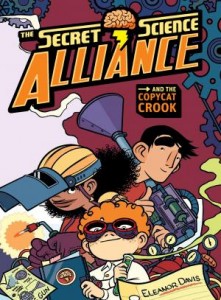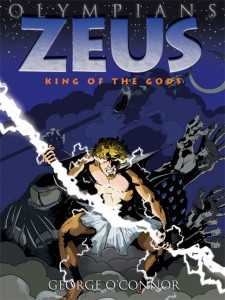So I wrote a post a week back called “The Myth of All-Ages” and people seemed to really respond to it, for which I am always grateful. I’ve read all of the comments at my original post a couple of times, and the responses that have appeared on other blogs, and I’ve really only got a one bit of follow-up. It’s a little scattered, but I figure it’s worth posting so here goes.
Some comics retailers are just out of touch with contemporary kids comics: Look, I’m all for venerating the pioneers of the Direct Market and I do respect their experiences selling comics, but I don’t think most retailers complaining about this issue are really aware of what comics are actually available for young readers these days. This is typified by the main arguments of Buddy Saunders of the Lone Star Comics chain as posted to ICv2. They seem to be entirely about the nature of superhero comics being different than they were 20 years ago, and that’s ‘fine’ I guess, but that’s an irrelevant argument to comics for kids. I think Tom Spurgeon summed it up best: If Mr. Saunders wants to keep moving the goalposts until he scores, by all means, but that doesn’t really solve anything.
Mr. Saunders’ most recent post at ICv2 is castigating the comic book market for not being able to capitalize on the successes of Twilight or Harry Potter like the book market has. This is based on an argument provided by a bookseller of prose books & graphic novels, of all things. At best Mr. Saunders is comparing apples and oranges (graphic novels and novels are both printed matter, but are different media). At worst, he’s brutally out-of-touch with both the graphic novel market and the market for teen/YA fiction. Simply, the market for YA and teen prose fiction is massive, with more books published for those two demographics than there are total graphic novels published in English every year, maybe 6-10 times the amount. ICv2 estimated about about 5000 graphic novels a year are published, and that’s for every age group. This site estimates nearly 30,000 books were published for ‘juveniles’ alone last year, and that may not even include material for teens. Mr. Saunders and his quotee are comparing apples to industrial watermelon farms.
So, yes, it makes sense that when Harry Potter and Twilight do well, there are lots more books to sell those older kids and teenagers, because there are 2500+ books a month being published for kids and YA and teenagers anyway. So yes, book publishers had a breakout success, and started refining and promoting their existing lines and developing new ones to capitalize on it. That’s awesome! But unfortunately graphic novels for teens didn’t have that same breakout success, novels did, and the two don’t (necessarily) directly relate. Further, while there has been a consistent build in the number of comics and graphic novels for kids (and their quality!) published in the last few years, that number still pales in comparison to how many novels for that same audience are being published, and to be honest there are dozens of great comics and graphic novels for kids, teens, and everyone in-between, that completely fly under the radar anyway, not finding the marketing support or sales they deserve in comic stores or ‘regular’ book stores. The market is printing books for young readers as fast as they’re salable, perhaps even more so. Saying otherwise underlines a profound lack of experience in this market.
I’ve had the pleasure of a nice dinner with Chris Powell, Buddy’s right-hand-man at Lone Star Comics, and he’s a smart, passionate retailer who really believes in bringing in comics for every age group walking through the doors of a Lone Star Comics shop. I have no doubt that those are great stores with an amazing selection of kids comics, and with more and more coming in every day. I really look forward to visiting a Lone Star Comics at some point. But I don’t understand why Mr. Saunders is still arguing that these books don’t exist, unless it is still the fact that it’s really just about him getting the exact sort of comics he wants, which are superhero comics from the early-80s or older, which were targeted at older readers but could still be enjoyed by some younger ones, which I took great pains to point out ain’t gonna happen in that last post.

So, anyway.
I didn’t mention anywhere in the original post that in 2009 I published a comic book for kids. Like, I actually did that myself, with the help of some very talented creators. It’s called COMICS FESTIVAL! and we sold about 22,000 of them into the direct market. It’s a great book, if I do say so, with like 30 pages of comics for kids, leading to more than a dozen comics and graphic novels currently in-print for kids. If you can track one down, I recommend it!
I truly believe in comics for children, and middle-grades, and young adults, and teens, and I spend a lot of time with that material. I know it’s not really fair as an arguing tactic to ask people to just accept on faith that I know what I’m talking about and things are ACTUALLY really great right now when it comes to comics for kids, but they are, and I hope they will.
I don’t just write 4,000 word essays about stuff for nuthin’. Peace-out.
– Christopher






I’m not disagreeing with you, but graphic novels sort of did have a breakout success with the YA/teen crowd: Manga. Or maybe your point was that even that didn’t reach Harry Potter/Twilight numbers, in which case never mind.
Michael: That’s a good point, but I’m trying really hard to completely excise manga from the discussion. As soon as I bring it up, I know I’m going to get the “But we can’t sell manga!” chants from the crowd and the usual excuses for why manga doesn’t work for that particular store. I’m trying to keep the discussion larger than one individual store’s likes and dislikes (or a particular mindset let’s say…), and manga is honestly such a controversial product with so many hoary-cliche arguments that it’s better if we confine the discussion to exclude manga. But yeah, clearly manga has been a game-changer (for the better). Maybe I do have another post on this.
To give a probably un-educated guess as to the distinction in success of the novel for kids/teens to comic books/GN; I would say it totally relates to distribution points rather than quality/content of the medium the material is confined to.
It is FAR easier (and trendier?) to go to Chapters/Indigo than a comic/graphic novel store.
I can’t tell you the last time I saw a table full or featured section in C/I go teen graphic novels, but go now and you can see several version of the same un-inspired vampire anthology.
Until comics and graphic novels really break out of the plaza/down the alley locations and hit mainstream distribution of a mega location; you are correct in the apples and watermelon comparisons, because there isn’t any.
Yes, you do. Go for the trifecta! 🙂